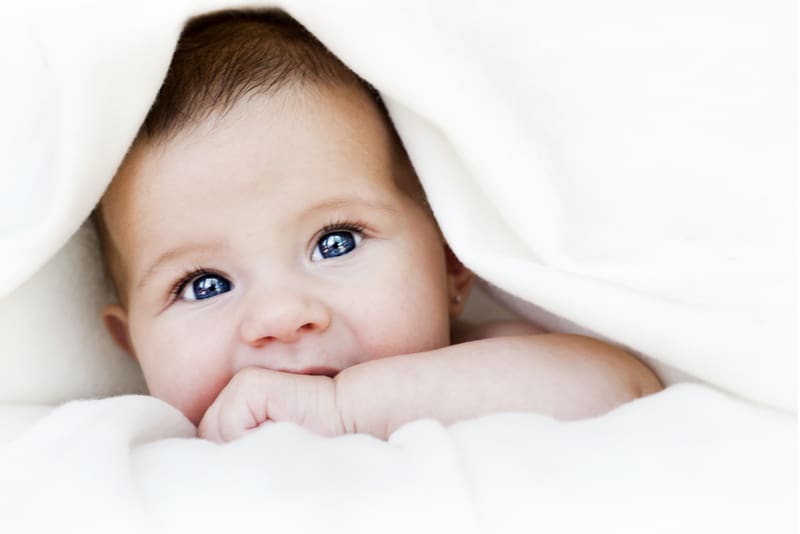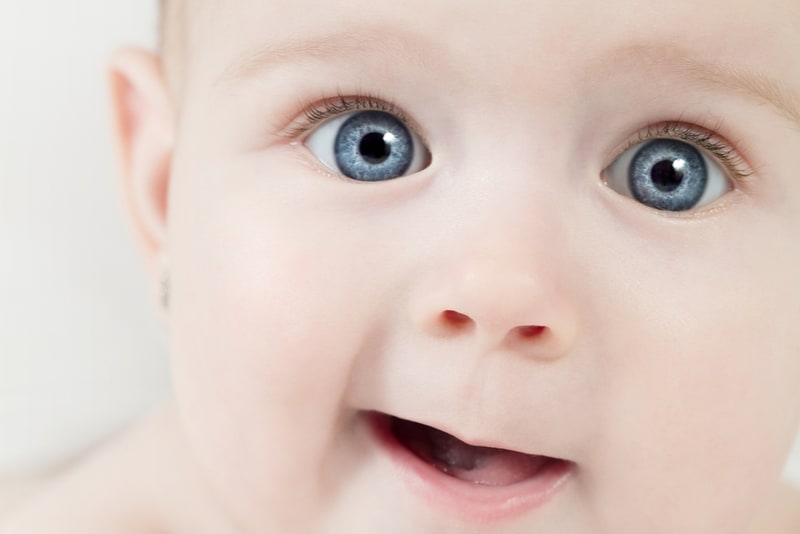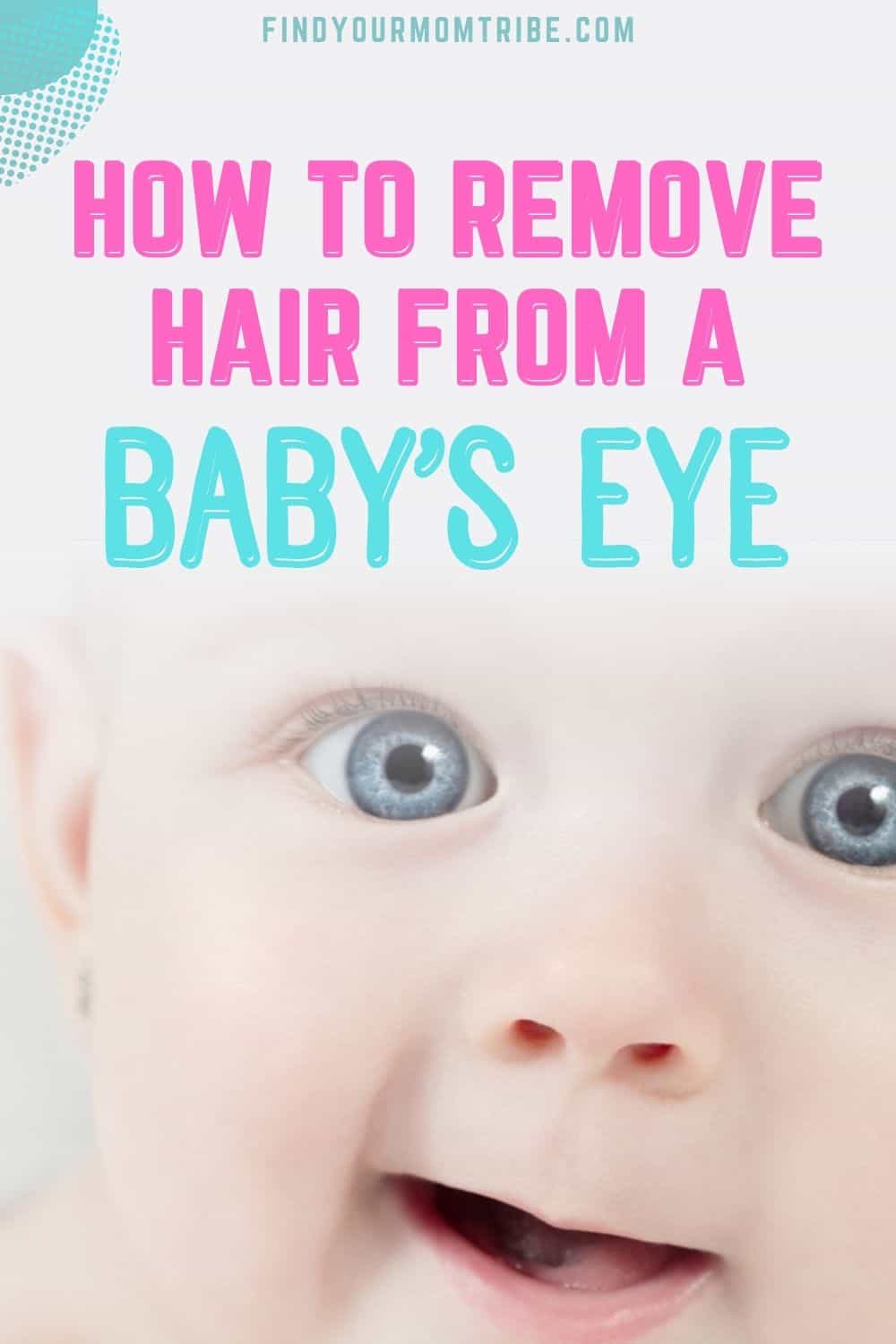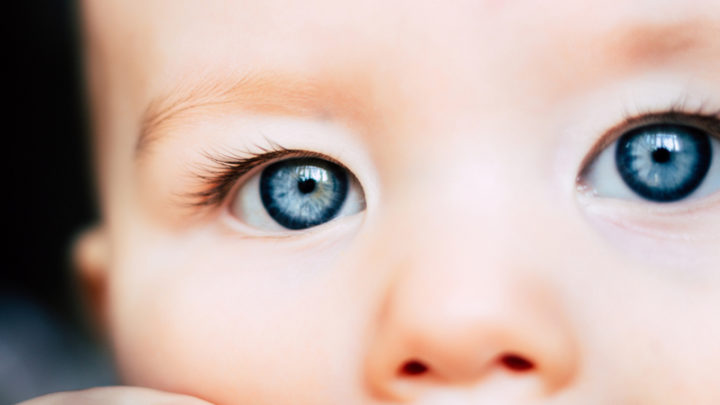If you notice that there’s a hair in baby’s eye, you’ll probably want to remove it ASAP.
But removing the hair in baby’s eye requires a gentle, methodical approach so you can get it done with as little fuss as possible.
You can’t just let your baby keep rubbing his eye as it could cause an injury to his cornea or worse.
Your best friends in a situation like this are warm water and a cotton swab. If that fails, going to a pediatrician or another healthcare professional should be the next step even for something as small as this that may seem harmless.
That being said, read on to find out what exactly the correct method is for extracting hair from a newborn’s eye, what you should and shouldn’t do when considering these procedures, and the potential complications.
What To Do If There’s Hair In Baby Eye?

Normally, a hair in the eye clears up on its own as the eye is fully capable of expelling different irritants and foreign objects through a few tears and blinks.
But sometimes, the issue persists and this can be rather irritating to babies and children.
Although it shouldn’t present too big of a problem, certain factors make it a difficult experience, the most important one being your child’s ongoing discomfort and instinctive attempts to keep rubbing his eyes to try and fix the problem.
This usually does more harm than good, as it can damage the eye if your little one isn’t careful.
The other difficulty arises when you try to remove the hair from the baby’s eye. It’s hard to tell whether you’re being too forceful or not, and this gives parents anxiety.
This is why the riskier treatments should be left to medical professionals. However, for the most part, you’ll easily be able to remove the hair at home with the following steps.
Steps for removing hair from a baby’s eye
Whether it’s a small strand of your baby’s hair or an eyelash, here are the steps to remove it safely from your baby’s eye:
1. Make sure to be in a well-lit room.
2. Wash your hands thoroughly so you don’t transfer bacteria to the baby’s eye.
3. Find a way to keep the baby still, either by having someone assist you or swaddling him beforehand. The latter will provide some comfort and help keep him calm instead of panicking.
4. Separate the lower eyelid from the upper eyelid delicately with your fingers, don’t press more than necessary in case your baby jerks around.
5. Don’t use your fingers or anything sharp to remove the object. That just makes the process riskier and you could end up seriously injuring your child.
Instead, use a gentle washcloth, a cotton ball, or a damp Q-tip for precision and either dab on it softly or wipe with gentle motions until the hair is caught and removed.
6. If #5 fails, use a bit of lukewarm water, baby-safe eye drops, or any other form of saline solution to help flush the baby’s eye clean.
7. Whatever happens, don’t panic. You need a set of calm hands for this and panicking will only make things worse.
What Not To Do When Trying To Get Hair Out Of Baby’s Eye

There are certain things you should never do during such procedures to avoid hurting your baby’s precious eyes.
Regardless of whether your baby has brown, green, or blue eyes, the most important thing is to follow a few simple steps to avoid any complications.
Here are some of the most important things that you SHOULDN’T DO during the procedure:
1. Don’t attempt this procedure before washing your hands or making sure that the rest of the material coming into contact with the baby is clean. Dealing with an eye infection is way worse than a hair in baby’s eye.
2. Never use anything sharp or bring anything sharp near the child’s eye.
Tweezers might sound helpful, but they’re dangerous and should never be used around the eye socket for children or even adults. Just let the tear ducts do their job.
Be mindful of your fingernails as well.
3. Don’t try pushing the hair out. Babies are extremely gentle beings, especially newborn babies, and applying too much pressure could lead to an unwanted injury while the problem might still persist.
4. Never use hot water on your child. Using it on the skin is dangerous enough as it might end up scalding your little one and causing severe burns, but the eye is even more sensitive and application of it could cause permanent and irreversible damage to your child’s face.
How To Properly Flush Out The Baby’s Eye

As mentioned before, if your baby’s tear ducts can’t do the job, flushing out the baby’s eye with saline solution, baby-safe eye drops, or lukewarm water is another alternative to cleansing any foreign objects from the eye socket.
Here’s what you’ll need to do it properly:
1. A pitcher filled with either cool or lukewarm water (the latter is better).
2. A smaller cup with a spout to control the flow of water when pouring it for precision and safety.
3. An eye dropper, if you’re dealing with a newborn or a baby who’s still in his first year of life, to not cause him distress.
4. Saline solution, fake tears, or baby-safe eye drops. Any one of these three will work as they’re all just a safe, neutral boost to the tear ducts.
5. A washcloth or a gentle towel to dab the excess water away from the baby’s face.
Once you have all of that handy, you’re ready to proceed.
Position the child’s face properly by placing a towel underneath the affected eye to catch the flow of water and prevent the water from going into your baby’s mouth.
Then, use your fingers to open the eyelids and gently pour the water from the cup into the baby’s eye.
The process should take a maximum of 15 minutes if you can keep the child still for that long or until you see the hair in baby’s eye wash away.
When Should I Call A Doctor?

It’s pretty rare for something like a stray eyelash to cause any real problems but if it does happen, it’s worth knowing how to recognize the problems that would require assistance from a pediatrics specialist or any other qualified healthcare professional.
Here are the most common signs that a doctor needs to intervene:
• You’re unable to remove the object yourself using the safer methods.
• The problem eye is still acting up after a few hours and your child is complaining about pain or the eye itself looks red or irritated. The clearest signs of irritation, apart from redness, are the eye constantly tearing up or streaming tears and your child persistently rubbing the eye even if the hair or foreign object has been removed.
• If the foreign object is still stuck inside the eye socket after 1-2 hours.
• There is pus or blood coming from the eye.
How Can I Keep My Baby From Constantly Rubbing His Eyes?

The steps to getting the hair out of your baby’s eye sound simple enough, but there’s always that one glaring problem – keeping your child still.
If something is wrong, your child will likely fidget a lot to signal that he’s panicking or is in distress. The same applies if he has a hair or an eyelash or some other foreign particle stuck underneath the eyelid.
His immediate reaction, and the immediate reaction of any other human being, would be to instantly start trying to rub it out.
If he continues, he’ll either get in your way while you’re trying to help or he might end up making the problem worse by irritating the eye further or even causing an infection.
There are a few ways to prevent your little one from rubbing his eyes while you try to help him.
The first and best thing that you can do is have someone help you. Whether it’s your partner, an older sibling, or anyone else for that matter, a set of extra hands never hurts.
The other option, especially for young babies, is to use a swaddle and wrap him up so he can’t wrestle out of it. It’ll also double as a comfort zone that’ll keep him warm and be soothing, assuring him that everything’s going to be okay.
In addition to either of the above (or both), you can also try keeping him calm by talking to him during the process. There’s nothing like the soothing sound of a mother’s voice to keep the baby from panicking.
If you’re still having trouble, use a paper cup and some medical tape to close the area off to prevent your child from irritating it any further until you can find a solution.
In Conclusion

Gazing upon the pigment of your child’s blue, green, brown eyes or whatever the baby’s eye color is can be truly mesmerizing so it’s a shame when something irritates them such as a hair in baby’s eye.
It’s perfectly normal for you to wonder, “Will my baby be okay?” in this situation, and, in most cases, the answer is “yes!”
However, there are a few rare situations where it might be a problem.
The eye’s tear ducts and the very act of blinking should be enough to get that pesky particle out of the eye and stop the irritation from occurring further, but sometimes they’re not enough and you have to intervene.
There’s no need to call the doctor just yet, instead, try getting it out yourself with a gentle approach. Everything you need should be in your first aid kit and in the kitchen.
The procedure is rather straightforward and harmless to the baby. Your only issue is going to be keeping the baby still.
If, after the procedure, your child is still having issues, or the situation is getting noticeably worse, it’s time to phone up your pediatrician to get the thing sorted.
Ultimately, this is nothing complicated or anything to panic about, so try to keep a level head and everything should turn out just fine with your child coming out of it safe and sound and ready to play again.
Like this post? Please share or pin it for later. You can also stay in the loop and follow us on Facebook, Instagram or Pinterest.

We love honesty! Find Your Mom Tribe is an Amazon Associate and we earn from qualifying purchases through affiliate links at no extra cost to you. Please see our full Amazon Affiliate disclosure for more information.

